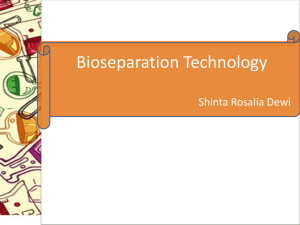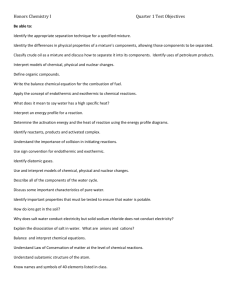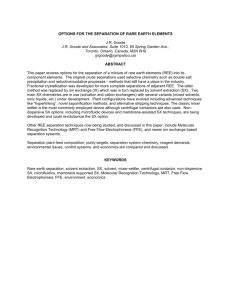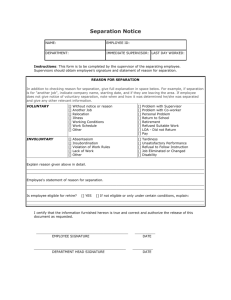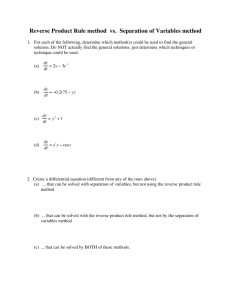1 Chapter 3 Separation Processes (Unit operations) (Refs
advertisement
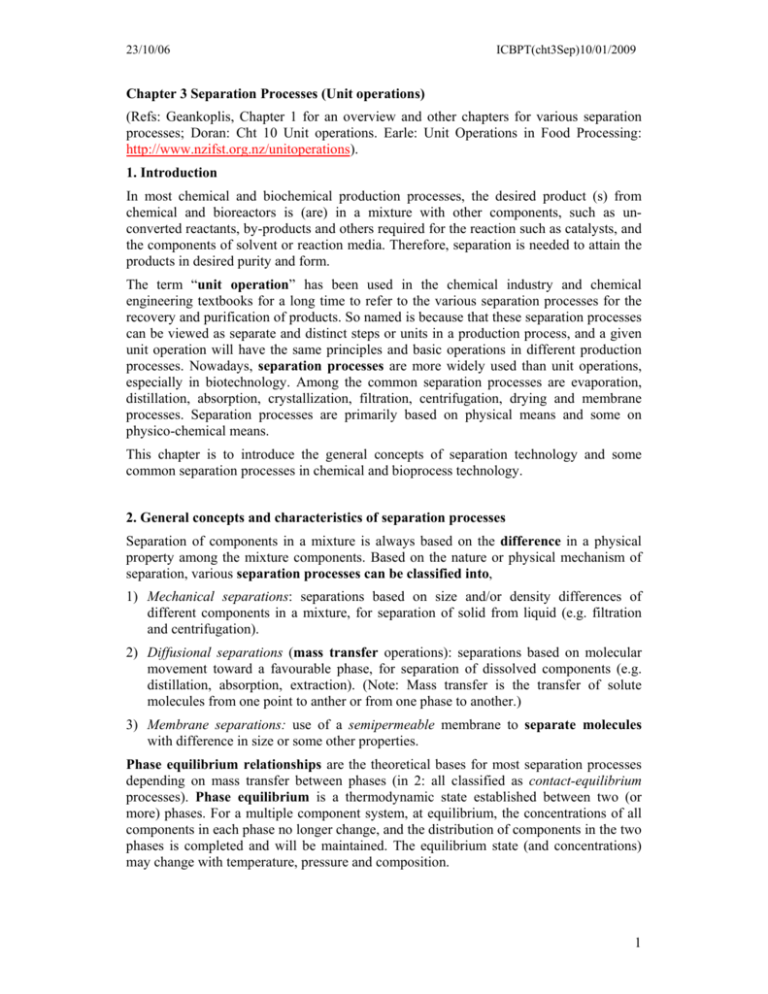
23/10/06 ICBPT(cht3Sep)10/01/2009 Chapter 3 Separation Processes (Unit operations) (Refs: Geankoplis, Chapter 1 for an overview and other chapters for various separation processes; Doran: Cht 10 Unit operations. Earle: Unit Operations in Food Processing: http://www.nzifst.org.nz/unitoperations). 1. Introduction In most chemical and biochemical production processes, the desired product (s) from chemical and bioreactors is (are) in a mixture with other components, such as unconverted reactants, by-products and others required for the reaction such as catalysts, and the components of solvent or reaction media. Therefore, separation is needed to attain the products in desired purity and form. The term “unit operation” has been used in the chemical industry and chemical engineering textbooks for a long time to refer to the various separation processes for the recovery and purification of products. So named is because that these separation processes can be viewed as separate and distinct steps or units in a production process, and a given unit operation will have the same principles and basic operations in different production processes. Nowadays, separation processes are more widely used than unit operations, especially in biotechnology. Among the common separation processes are evaporation, distillation, absorption, crystallization, filtration, centrifugation, drying and membrane processes. Separation processes are primarily based on physical means and some on physico-chemical means. This chapter is to introduce the general concepts of separation technology and some common separation processes in chemical and bioprocess technology. 2. General concepts and characteristics of separation processes Separation of components in a mixture is always based on the difference in a physical property among the mixture components. Based on the nature or physical mechanism of separation, various separation processes can be classified into, 1) Mechanical separations: separations based on size and/or density differences of different components in a mixture, for separation of solid from liquid (e.g. filtration and centrifugation). 2) Diffusional separations (mass transfer operations): separations based on molecular movement toward a favourable phase, for separation of dissolved components (e.g. distillation, absorption, extraction). (Note: Mass transfer is the transfer of solute molecules from one point to anther or from one phase to another.) 3) Membrane separations: use of a semipermeable membrane to separate molecules with difference in size or some other properties. Phase equilibrium relationships are the theoretical bases for most separation processes depending on mass transfer between phases (in 2: all classified as contact-equilibrium processes). Phase equilibrium is a thermodynamic state established between two (or more) phases. For a multiple component system, at equilibrium, the concentrations of all components in each phase no longer change, and the distribution of components in the two phases is completed and will be maintained. The equilibrium state (and concentrations) may change with temperature, pressure and composition. 1 23/10/06 ICBPT(cht3Sep)10/01/2009 The equilibrium concentration represents the maximum extent a separation process can reach. The thermodynamic basis for achieving separation is that all matters in nature have the tendency to reach equilibrium. The driving force for separation of a component from the original mixture to another phase is the difference between the initial/actual concentration and the equilibrium concentration. For example, two well-known equilibrium relationships are Rauolt’s law for vapor-liquid equilibrium used in distillation, Henry’s law for gas-liquid equilibrium used for gas absorption. 3. Common separation processes 3.1. Evaporation The general definition of evaporation is the loss or disappearance of a liquid due to vaporization. In the process industry, evaporation process is to concentrate a solution (of a non-volatile solute) or to separate a volatile solvent from a non-volatile solute, by vaporizing and removing part of the solvent (mostly water). In an evaporation process, the liquid solution is usually heated to boiling by steam. The rate of evaporation is proportional to the rate of heat transfer. Therefore, the major part Fig. 1 Evaporation process, heat and mass of most evaporators is similar to a heat exhanger. balances (x-conc, H-enthalpy, B-boiling pt.) Example applications: the concentration of aqueous solutions of sodium hydroxide, sodium chloride, glycerol, sugar and glue and milk. In these cases, the concentrated solution is the desired product and the vaporized water is discarded. In a few cases such as the production of solids-free water for boiler and drinking water from sea water, the vaporized water is condensed as the product. Evaporation is often connected to, or combined with crystallization to attain a solid product. (Ref: http://www.techfak.uni-kiel.de/matwis/amat/elmat_en/kap_6/backbone/r6_4_3.html ) 3.2. Crystallization Crystallization is the formation of solid particles within a homogenous phase, usually a liquid solution. (The crystallization process in a gas phase is known as sublimation.) It is a solid-liquid separation process, which usually occurs at late stage of product processing. After the process, the crystals are usually dried as the final product for packaging. An important application of crystallization is in the production of sucrose (cane sugar) from sugar cane. Crystallization is a process of mass transfer of the solute from the liquid phase to the surface of crystal particles. Crystallization is the reverse process of solution, to dissolve a solid in a liquid. To crystallize the solute in a liquid solution, the solution needs to be concentrated to supersaturation, which can be achieved in three ways, 1) Cooling, for solutes with a solubility increasing rapidly with T; 2) Evaporation, for solutes with solubility independent of T; 3) Both 1 and 2: for solutes with solubility dependent on T but not so strongly as 1. (Ref: http://www.cheresources.com/cryst.shtml ) 2 23/10/06 ICBPT(cht3Sep)10/01/2009 Ex 9.8 (R.L. Earle Unit Operations in Food Processing: www.nzifst.org.nz/unitoperations) If a sodium chloride (NaCl) solution in water at 40°C has reached a concentration 50%, calculate the quantity of NaCl crystals that will form once crystallization has been started in per 100 g water. The solubility of NaCl at 40°C is 36.6 g/100 g water. Solution: Wt of salt in solution = 50 g/100 g solution = 100 g/100 g water. Sat. conc = 36.6 g /100 g water. Wt of salt crystallized out = (100 - 36.6) g/100 g water = 63.4 g/100 g water. 3.3. Filtration and centrifugation (solid-liquid separation) Filtration is the mechanical separation of solid particles from a fluid by passing the fluid through a filtering medium, or septum, on which the solids are deposited. The most common filtering medium is fabric cloth with strong mechanical properties. The fabric causes the solid particles to become entangled on the surface of the cloth, resulting in the formation of a layer of solids, and the buildup of the solids on the layer. Filtration separation is driven by the pressure difference (Δp) between two sides of the filtration medium, created either by a pressure on the upstream side, by a vacuum at the downstream side, or by a centrifugal force (Fig. 2). p1 In batch filtration, as the solid layer deposited on the filter increases its thickness with time, the resistance to the fluid flowing through the filter increases. The rate of filtration will decrease if a constant pressure is applied to the fluid. Usually the solid (filter cake) is removed periodically from the filter before the resistance becomes extremely high. The rate of filtration is strongly affected by properties of the slurry, compressibility of solid cake and viscosity of liquid. Slurry Filter cake Filter cloth Support to filter cloth p2 Filtrate Fig. 2 A simple filtration device. Centrifugation separates materials of different densities with a force greater than gravity. Centrifugation intensity is usually given by the ratio of centrifugal force to gravity, with the unit of “g”, Fc / Fg = ω 2r g ω = 2πN, the angular velocity of centrifuge; N = rotation speed common known as rpm or rps; r = radial distance of the particle from the centre or the radius of the bowl; g = gravitational acceleration constant (=9.806 m/s2). Filtration versus centrifugation: 1) Both belong to mechanical separation, solid from liquid. 2) Filtration, based on particle size. 3) Centrifugation, based on density difference (can be used for liquid-liquid separation). 3 23/10/06 ICBPT(cht3Sep)10/01/2009 4) Filters are usually simpler and cheaper than centrifuges. 5) Centrifuges can be used for particles which are difficult to filter, e.g., very small and compressible ones. 3.4. Drying of solid Drying is the removal of the moisture content in a material. In most cases, the material being dried is a solid and the moisture is water. Drying usually occurs at the end of a production process (for product polishing or finishing), the dried product is ready for packaging. Common drying method/process: the solid to be dried is brought into contact with a stream of hot air (drying air), which vaporizes the water in the solid and carries away the water vapor. The rate of drying mainly depends on the humidity and flow rate of drying air, the state and content of moisture in the solid, the drying temperature and the drying area. 3.5. Two-phase contact processes 3.5.1. General features and classification Many chemical and biological process materials exist as homogeneous mixtures of different components in a gas, liquid or solid phase. To separate or remove one or more components from a gas, liquid or solid mixture, the mixture is usually brought into contact with another phase (to create the separation driving force and environment). The two phases can be gas-liquid, gas-solid, liquid-solid, or liquid-liquid. During the contact between the two phases, the components can diffuse from the original mixture into another phase, resulting in the redistribution of the components in the two phases. The two phases are then separated by simple physical/mechanical methods. Gas Liquid Gas Liquid (McCabe et al.) Fig. 3 Packed column (left) and tray (plate) tower (right) for two-phase contact processes. 4 23/10/06 ICBPT(cht3Sep)10/01/2009 Therefore, most of the separation processes based on mass transfer are carried out in twophase contact processes. Two-phase contact processes can be accomplished in single-stage or multiple-stage systems, and operated in batch or continuous mode. Packed tower (column) is commonly used for continuous-contact processes (single-stage) and plate or tray tower for multi-stage processes (Fig. 3). A packed tower is a cylindrical column filled with packings which provide the gas-liquid contact area. The two phases always flow in countercurrent direction thru these towers (to maximize the mass transfer driving force), with the gas or light phase entering at the bottom and exiting at the top, and the liquid or heavy phase entering at the top and exiting at the bottom. 3.5.2. Absorption (or gas absorption) is the removal of a solute (component) from its gaseous mixture by means of a liquid which dissolves the solute gas. In most cases, the gas solute being absorbed is the less abundant component or has a very low content in the gas phase. Absorption is more commonly carried out in packed towers than in plate towers. Applications of gas absorption: In coke plants, to absorb by-product gases, such as ammonia with water, and benzene and toluene with oil. Air pollution control: removal of pollutants in gaseous effluents such as removal of H2S from the coal combustion process in electrical power plants by aqueous solution of alkaline salts (lime stone CaCO3). In most abruption processes, the component being absorbed is the less abundant or at relatively low content in the gas. Synonyms of gas absorption: scrubbing so the equipment called absorber or scrubber. The reverse process of absorption is stripping (in a stripper), the removal of a solute from liquid solution by a gas. The rate of absorption depends strongly on the solubility of the gas solute in the liquid. The solubility of a gas in a given solvent increases with pressure (based on Henry’s law pA=HxA, pA = partial pressure of solute A in gas and xA = mole fraction A in liquid, and H Henry’s law constant). Ex 9.3 (Earle) Solubility of carbon dioxide in water. Given the Henry's Law constant for carbon dioxide in water at 25°C, H = 1.6×105 kPa/mole frac, calculate the solubility of CO2 wt% of water at a CO2 partial pressure of 200 kPa in the gas phase above water. (Ans 0.31%). 3.5.3. Distillation (fractional distillation) is the separation of components in a liquid mixture by a process involving partial vaporization. Separation of the constituents is based on differences in volatility (or vapor pressure, boiling point). Distillation is mostly carried out in tray or plate towers (Fig. 3). In the tower, the rising vapour contacts with the falling liquid on trays, achieving mass transfer between the two phases. The more volatile (lighter) component increases its conc. from bottom to top, while the less volatile (heavier) increases conc. from top to bottom. Distillation is one of the most important separation processes in chemical and other process industries. For example, oil refining: petroleum into several fractions such as light gases, naphtham, gasoline, kerosene, fuel oils, lubricating oils and asphalt); Distillation of liquid air to produce pure oxygen for use in steel-making, in rockets, and medical applications; Ethanol (alcohol and beer) separation from fermentation medium. 5 23/10/06 ICBPT(cht3Sep)10/01/2009 3.5.4. Extraction is the use of a liquid to separate a component from either a solid or a liquid solution. Here we only consider liquid-liquid extraction (also called liquid extraction or solvent extraction). Extraction separation of a solute from a solution is based on the difference in the solubility of solute in two solvents. (Ref: http://orgchem.colorado.edu/hndbksupport/ext/ext.html ) Theory or principles of solvent extraction K=Y/X, partition or distribution coefficient, an equilibrium constant independent of solute conc. for a given pair of solvents and at given temperature and pH. Y, X= solute conc. in the light and heavy phase, respectively. Extracting solvent L, Y Extract phase H, X Raffinate phase Solution Before mixing Mixing Phase Separtion Fig 4. Basic concept and process of liquid-liquid extraction. The most common criteria for solvent selection is polarity because ‘like dissolves like’. The relative polarity of different solvents can be compared with the dielectric constant D which is a measure of the degree of molecular polarization of a compound (such as those shown in Table 2). Table 2 Dielectric constants of solvents at 25 oC in order of polarity (Stanbury) Solvent D Solvent D Hexane (least polar) 1.90 Acetone 20.7 Benzene 2.28 Ethanol 24.3 Chloroform 4.87 Methanol 32.6 Ethyl acetate 6.02 Water (most polar) 78.5 Fig. 5 presents the separation funnel used in laboratory for small volumes of samples, and the mixer-settlers used in large-scale processes. 6 23/10/06 ICBPT(cht3Sep)10/01/2009 Fig. 5 Extraction versus distillation (based on Geankoplis): - When either distillation or extraction may be used, the choice is usually distillation. In extraction, the solvent must be recovered for reuse (usually by distillation). - Extraction utilizes chemical difference instead of vapor pressure difference. - When distillation is ineffective, such as substances that cannot withstand high temperature of distillation (e.g., penicillin). - Extraction can separate petroleum products that have different molecular structures but about the same boiling range. 3.6. Membrane Separations Separation by the use of membranes has been increasingly used in the chemical and bioprocess industry. In membrane separation, the membrane acts as a semipermeable barrier which only allows for certain molecules to pass through it. This is a fundamental difference of membrane separation from filtration, that separation in filtration is controlled by the solid being filtered but not the filter cloth, but the separation in membrane processes is dominated by the membrane. (Ref: http://www.foodsci.uoguelph.ca/dairyedu/membrane.html ) 3.6.1. Dialysis is the removal of small solute molecules from a liquid with a membrane which allows for the small solutes but not large molecules to diffuse through. On the other side of the membrane is another liquid, the dialysing liquid, which contains lower concentrations of the small solutes. The small solute Large molecule molecules diffuse from the Small solute molecule solution to the dialysing liquid through the membrane because of the concentration difference. Dialysis membrane Distinct characteristics from other membrane processes: low flux rates, not relying on high pressure. 7 23/10/06 ICBPT(cht3Sep)10/01/2009 Applications: desalting protein solutions. Often coupled with (protein) precipitation (with salts). An important application: Hemodialysis, the use of artificial kidneys to remove small solutes including urea, uric acid, creatinine, phosphates and excess amounts of chloride in the blood of patients with kidney diseases. 3.6.2. Reverse osmosis Osmosis (as a natural phenomenon) is the flow (diffusion) of water molecules through a semi-permeable membrane from low-solute concentration side to high-solute concentration side of the membrane. The net movement of water to one side causes a liquid level difference between the two sides, and this flow of water will stop when the liquid level difference is equal to the osmotic pressure of the solution. pressure Osmotic pressure Water Pure water Water Ethanol or salt solution Semipermeable membrane Water Pure water Ethanol or salt solution Semipermeable membrane Fig. 6 Osmosis and reverse osmosis Reverse osmosis is the use of high pressure to force the flow of solvent (e.g., water) molecules in the reverse direction of osmotic pressure. Applications of reverse osmosis include: water purification, sterilization, dewatering and the separation of components in a mixture. Specifically 1) recovery of protein and sugar from cheese whey 2) concentration of fruit juice and milk 3) dewatering of sugar solution 4) concentration of antibiotics 5) desalination of sea water and wastewater treatment 3.6.3. Ultrafiltration (超滤) Ultrafiltration (UF) is used for the separation of macromolecules (polymers) such as proteins, with molecular weights 1000-50,000. It is a high-pressure membrane process, up to 145 psi (10 bar). In UF, the separation is mainly based on the size of molecules and the membrane acts as a "molecular filter" and the membrane pore size controls the size of molecules to pass through (molecular weight cut-off). The solvent and small solute molecules pass through the membrane, collected as permeate; larger solute molecules do not pass through the membrane and are recovered in a concentrated solution (the retentate). 8 23/10/06 ICBPT(cht3Sep)10/01/2009 Applications in bioseparation: protein separation. UF processes: 1) Dead-end filtration: The feed flows on to the membrane. There is a rapid deposition of the macromolecules, and the formation of a cake (gel layer) on the membrane surface or concentration polarization, which increases the flow resistance and reduces the flow rate (flux) through the membrane. This is an unfavourable flow direction, not commonly applied in large-scale processes (but still occurs in some lab UF devices). 2) Cross-flow or tangential flow filtration is commonly used in modern processes, with the feed flowing in the direction parallel to the membrane surface. This flow direction can reduce the flow resistance arising from gel formation and increase the filtrate flux through the membrane. Microfiltration (MF) is a membrane process using lower pressure (1-50 psi) than UF, for the separation of micronFig. 7 Various membrane devices (configurations). sized particles such as microorganisms (bacteria, yeasts and viruses), and small particles such as colloidal dispersions of clays, latex particles (typically 0.02-10 μm). Bioprocess applications: sterilization of liquid and air, fermentation broth clarification. However, there is no clear-cut division between UF and MF and the two can have a wide range of overlap. Three distinctive characteristics of UF processes: operate at a high cross-flow, dominated by the membrane, and dependant on the membrane geometry in the actual equipment. (Belter et al.1988). Summary (Chapter 3 Separation processes) Aim: to gain a general knowledge of various separation processes and their applications, and recognize their functions in a chemical and bioprocess plants. 1. Classification of separation/downstream processes, and the separation mechanism and applications of each class. 2. Phase equilibrium concept and application in separation; solute concentration and solubility in crystallization; Henry’s law and gas solubility. 9 23/10/06 ICBPT(cht3Sep)10/01/2009 3. For various separation processes, have a general knowledge of the process, separation mechanisms, driving force, rate-limiting factors, and the common processes and types of materials and equipment, applications, and limitations. 4. Separation processes introduced in this lecture: evaporation, crystallization, filtration, centrifugation, drying, absorption, distillation, liquid-liquid extraction, membrane separation processes (dialysis, reverse osmosis, ultrafiltration). Review questions: 1. Compare the similarities and differences between filtration and membrane separations. 2. What does it mean by “dead-end” or “cross-flow” in Ultrafiltration processes? How the flow direction affects the UF and MF processes? 3. What are the major differences between dialysis and ultrafiltration? 4. Sketch the concentration profile of solute in each phase along an absorption tower. 5. Which property of liquid is most useful for selecting extraction solvents based on polarity? 6. Tell two considerations in selecting extraction or distillation for the separation of a liquid mixture. 7. What is reflux, and the function of reboiler in distillation? What is the major function of packing in packed tower? 8. Describe/discuss the following aspects of various separation processes concisely: 1) 2) 3) 4) 5) 6) The separation mechanism or working principle. The material(s) being processed or involved. The major equipment, name, mechanical structure and how it works. The major operation steps and the functions of each. The major influential factors affecting the process, and how they affect. Major applications of the process in industry; its position and major functions in the whole plant process. 7) Alternative processes or methods for the same objective and comparison. Summarize these features in a table as follows Name of process Separation mechanism Influential factors Application 9. In a membrane process, which component passes through the membrane? 10. In a separation process, in which direction each component is moving (from one phase to another)? 10



